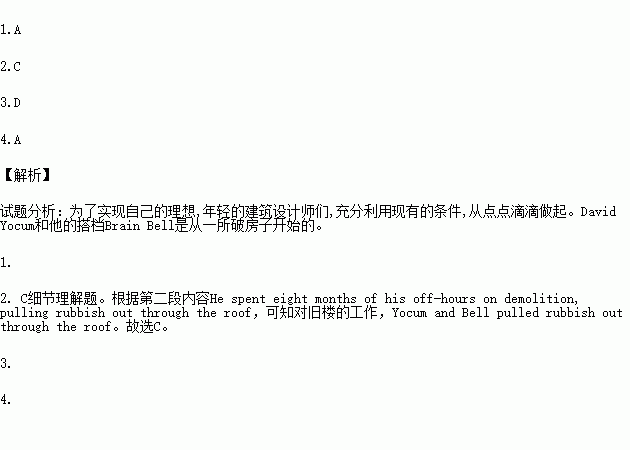题目内容
Most young architects—particularly those in big cities—can only dream about working in a building of their own. And making that dream come true often means finding a building no one else seems to want, which is exactly what happened to David Yocum and his partner, Brian Bell. Their building is a former automobile electrical-parts firm in Atlanta. From the outside, it looks too old, even something horrible, but open the door and you are in a wide, open courtyard, lined on three sides with rusting walls.
In 2000,Yocum and Bell found this building in the city’s West End. Built in 1947, the structure had been abandoned years earlier and the roof of the main building had fallen down. But the price was right, so Yocum bought it. He spent eight months of his off-hours on demolition, pulling rubbish out through the roof, because it was too dangerous to go inside the building. The demolition was hard work, but it gave him time to think about what he wanted to do, and “to treasure what was there—the walls, the rust, the light,” Yocum said. “Every season, more paint falls off the walls and more rust develops. It’s like an art installation(装置) in there—a slow-motion show.”
Since the back building had been constructed without windows, an all-glass front was added to the building to give it a view of the courtyard, and skylights were installed in the roof. The back of the building is a working area and a living room for Yocum and his wife. A sort of buffer(缓冲) zone between the front and the back contains a bathroom, a kitchen and a mechanical room, and the walls that separate these zones have openings that allow views through to the front of the studio and the courtyard beyond.
Yocum and Bell, who have just completed an art gallery for the city, feel that the experience from the decoration of their building, focusing on the inside rather than the outside, has influenced their work. It has also given these architects a chance to show how they can make more out of less.
1.According to the passage, it is_________ for most young architects in big cities to work in a building of their own.
A. unrealistic B. easy
C. unnecessary D. common
2.Working on the old building, Yocum and Bell_______.
A. removed the skylights from the bathroom
B. presented a slow-motion show in an art gallery
C. pulled rubbish out through the roof
D. built a kitchen at the back part of the old building
3.It can be inferred from the passage that Yocum and Bell ________.
A. benefited a lot from pulling down the roof
B. turned more old buildings into art galleries
C. paid more attention to the outside of the art gallery
D. got inspiration from decorating their old building
4.The main idea of the passage is that_________.
A. creative people can make the best of what they have
B. people can learn a lot from their failures
C. it is worthwhile to spend money on an old building
D. people should not judge things by their appearance

